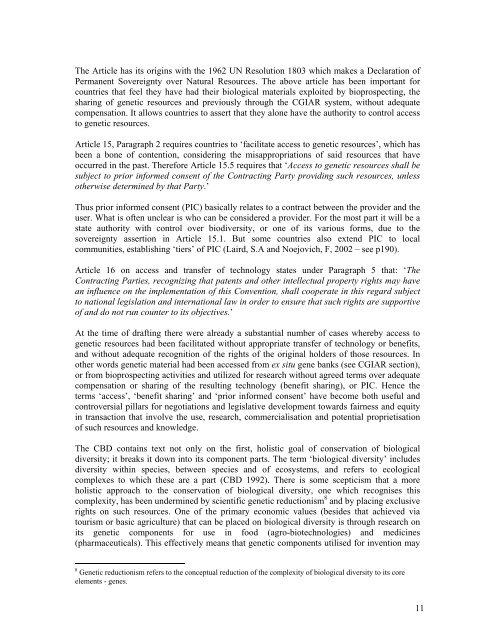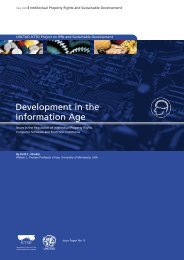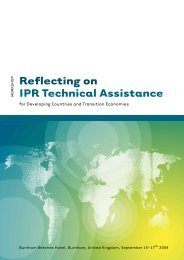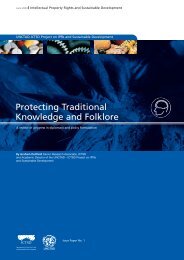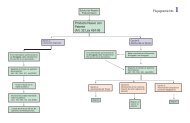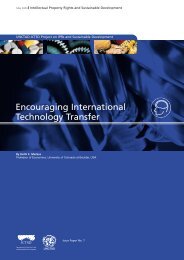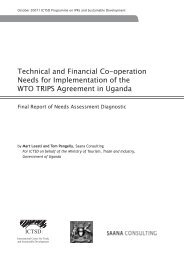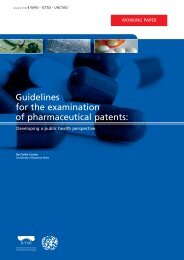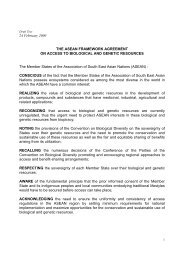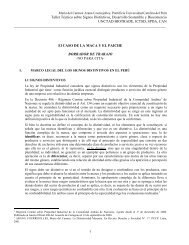Governance and Micropolitics of Traditional ... - IPRsonline.org
Governance and Micropolitics of Traditional ... - IPRsonline.org
Governance and Micropolitics of Traditional ... - IPRsonline.org
You also want an ePaper? Increase the reach of your titles
YUMPU automatically turns print PDFs into web optimized ePapers that Google loves.
The Article has its origins with the 1962 UN Resolution 1803 which makes a Declaration <strong>of</strong><br />
Permanent Sovereignty over Natural Resources. The above article has been important for<br />
countries that feel they have had their biological materials exploited by bioprospecting, the<br />
sharing <strong>of</strong> genetic resources <strong>and</strong> previously through the CGIAR system, without adequate<br />
compensation. It allows countries to assert that they alone have the authority to control access<br />
to genetic resources.<br />
Article 15, Paragraph 2 requires countries to ‘facilitate access to genetic resources’, which has<br />
been a bone <strong>of</strong> contention, considering the misappropriations <strong>of</strong> said resources that have<br />
occurred in the past. Therefore Article 15.5 requires that ‘Access to genetic resources shall be<br />
subject to prior informed consent <strong>of</strong> the Contracting Party providing such resources, unless<br />
otherwise determined by that Party.’<br />
Thus prior informed consent (PIC) basically relates to a contract between the provider <strong>and</strong> the<br />
user. What is <strong>of</strong>ten unclear is who can be considered a provider. For the most part it will be a<br />
state authority with control over biodiversity, or one <strong>of</strong> its various forms, due to the<br />
sovereignty assertion in Article 15.1. But some countries also extend PIC to local<br />
communities, establishing ‘tiers’ <strong>of</strong> PIC (Laird, S.A <strong>and</strong> Noejovich, F, 2002 – see p190).<br />
Article 16 on access <strong>and</strong> transfer <strong>of</strong> technology states under Paragraph 5 that: ‘The<br />
Contracting Parties, recognizing that patents <strong>and</strong> other intellectual property rights may have<br />
an influence on the implementation <strong>of</strong> this Convention, shall cooperate in this regard subject<br />
to national legislation <strong>and</strong> international law in order to ensure that such rights are supportive<br />
<strong>of</strong> <strong>and</strong> do not run counter to its objectives.’<br />
At the time <strong>of</strong> drafting there were already a substantial number <strong>of</strong> cases whereby access to<br />
genetic resources had been facilitated without appropriate transfer <strong>of</strong> technology or benefits,<br />
<strong>and</strong> without adequate recognition <strong>of</strong> the rights <strong>of</strong> the original holders <strong>of</strong> those resources. In<br />
other words genetic material had been accessed from ex situ gene banks (see CGIAR section),<br />
or from bioprospecting activities <strong>and</strong> utilized for research without agreed terms over adequate<br />
compensation or sharing <strong>of</strong> the resulting technology (benefit sharing), or PIC. Hence the<br />
terms ‘access’, ‘benefit sharing’ <strong>and</strong> ‘prior informed consent’ have become both useful <strong>and</strong><br />
controversial pillars for negotiations <strong>and</strong> legislative development towards fairness <strong>and</strong> equity<br />
in transaction that involve the use, research, commercialisation <strong>and</strong> potential proprietisation<br />
<strong>of</strong> such resources <strong>and</strong> knowledge.<br />
The CBD contains text not only on the first, holistic goal <strong>of</strong> conservation <strong>of</strong> biological<br />
diversity; it breaks it down into its component parts. The term ‘biological diversity’ includes<br />
diversity within species, between species <strong>and</strong> <strong>of</strong> ecosystems, <strong>and</strong> refers to ecological<br />
complexes to which these are a part (CBD 1992). There is some scepticism that a more<br />
holistic approach to the conservation <strong>of</strong> biological diversity, one which recognises this<br />
complexity, has been undermined by scientific genetic reductionism 8 <strong>and</strong> by placing exclusive<br />
rights on such resources. One <strong>of</strong> the primary economic values (besides that achieved via<br />
tourism or basic agriculture) that can be placed on biological diversity is through research on<br />
its genetic components for use in food (agro-biotechnologies) <strong>and</strong> medicines<br />
(pharmaceuticals). This effectively means that genetic components utilised for invention may<br />
8 Genetic reductionism refers to the conceptual reduction <strong>of</strong> the complexity <strong>of</strong> biological diversity to its core<br />
elements - genes.<br />
11


